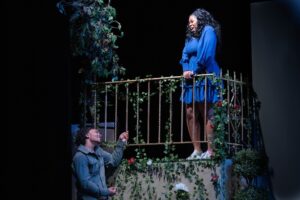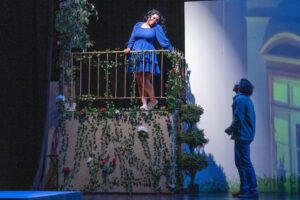Romeo and Juliet
William Shakespeare, Adapted by L. Peter Callender
African-American Shakespeare Company

Maybe no play of the Bard’s has been adapted more than the romantic tragedy of Romeo and Juliet in which the ongoing rivalry between two families leads to the deaths of two of their children who just happen to fall in love. On the stages of theatre, opera, and ballet and on the screens of film, the story speaks time and again to communities torn apart by long-brewing hate of almost any time period, any geography.
To this plethora of adaptations of William Shakespeare’s four-hundred-year-plus-old tale, the African-American Shakespeare Company’s Artistic Director, L. Peter Callender, pens and directs a honed-down, fast-paced, contemporary version of Romeo and Juliet, made particularly compelling and gripping with an excellent cast of actors mostly of color. While the character count is relatively small (i.e., nine) and some original scenes have been greatly edited, Peter Callender’s adaptation has retained the richness, beauty, and poetic melody of the Bard’s original text, on the whole delivered by the cast so naturally and artistically that the iambic-pentameter lines with their words of yesteryear sound totally as one might hear on the streets of today’s urban environment.
The modern scene is well established in the set design also created by the production’s adapter and director, particularly in the large projections on two vertical screens bunting up against the required bedroom balcony. Cityscapes, high-styled home interiors of the rich, lush gardens, and a park not unlike Central Park with a city’s skyline in the background are just some of the projected scenes that place this particular Verona somewhere in the urban U.S. Nia Jacobs dresses teens and adults in the cool garb of the young and the more sophisticated look of societal elders. A wide variety of contemporary and classical music of many ilk ties scenes together with the play taking on cinematic dimensions at times when the background music plays much like a movie’s score. Overall, the sound design of James Goode is a major contribution to placing the action in the now, with city sounds surrounding the entire Marines’ Memorial Auditorium as if we ourselves were in the middle of the scene at hand.
On one of this setting’s city asphalts, teens sauntering along eye one another with looks of contempt, leading to intentional, pass-by bumping. Tugs and bumps are followed by pushing and shoving along with taking a nearby garbage can and throwing it and its contents back-and-forth. All leads to repeated rounds of fist-pounding.
Suddenly approaching sirens sound, a helicopter’s loud whirl of blades hovers somewhere above; a spotlight shines on the kids; and an ominous, amplified voice warns, “If ever you disturb our streets again, your lives shall pay.” Even with that dire promise, two of the youths – Tybalt, nephew to the Capulet family, and Benvolio, nephew to the Capulet’s detested rivals, the Montagues, start the tussle anew, only to stop with the head of the Capulet family himself appears and sternly stares them into going their separate ways.
In the meantime, Capulet spreads on the street invitations to a festival event at his estate to occur that very night – a flyer that a passing, happy-go-lucky-appearing Romeo Montague reads with much excitement. He knows that at this party, his one true love, Rosaline, will likely be there – reason enough to convince his friends that they should sneak into enemy territory for a fun time at the masquerade to-do.
And thus are all the ingredients in place for the well-known events now to take place, both this night and the next day when young hot heads and long-held rivalries launch a series of seemingly unstoppable tragedies just as love is fully blossoming between Romeo and not Rosaline, but a girl he never intended to love until at first glance, he did.

As Romeo, Khari Haynes portrays the kind of kid one cannot help but like on meeting. At first glance, he is easy-going, quick to play around in a good and teasing way with his best buds, and one to wear his emotions on his sleeve as he espouses love – first for Rosaline, and then Juliet – beaming with anticipated infatuation expressed in his whole being. He is a kid always on the move, often running when he could walk, jumping with the moment’s excitement, or just bounding along giggling with the realization that Juliet might actually love him.

As part of a trio with cousin Benvolio and pal Mercutio, Romeo is totally at ease, even as they kid him about his starry-eyed infatuation for Rosaline (prior, of course, before the fateful night at the party when his attentions turn another direction). Wearing a backward-turned baseball cap, Justin P. Lopez is the good-hearted Benvolio who is rarely seen not munching on a half-unwrapped candy bar. He’s a pal’s pal, fast to put his arms around his friend’s shoulder while kidding around or providing his sincere advice about love and life.

Mercutio – in this adaptation, a blonde-headed, tattooed girl – is the most animated of the three buddies, with Devin Parker Sullivan absolutely knocking out of the park her depiction of the always jumpy, twitching, moving-in-every-direction-at-once teen. When Mercutio banters with her friends, her words are illustrated constantly by hand and body movements that act out whatever she is in the moment saying. She is quick to tumble with her buds, jump on one of their backs, and join in with both the others in a lip-sync with expressions and movements that could win first place at a local karaoke bar.
The one thing these three buddies share, however, is varying degrees of teenage a hot-head, un-thinking proneness to street brawling. Any encounter with the impetuous, cocky firebrand, Tybalt (played with fiery spark and spit by Gregor Haley), for example, is an immediate invitation for someone to throw the first punch.
Such happens on the fateful morning when Mercutio and Tybalt quickly come to fists after Mercutio taunts Tybalt with sounds and mimics of a meowing cat, leading to a full-on round of hard hits, kicks, and tumbles (kudos to fight coordinator, Dave Maier). As tempers skyrocket, we watch what too often seems to happen daily in our local streets of San Francisco, Oakland, or you-name-the-city: A knife appears out of nowhere, a struggle ensues, a friend (Benvolio) tries frantically to pull them apart, and then a blade appearing from nowhere plunges into a gut, leading to a needless, totally unintended death. The scene as played out – along with the subsequent surge of venom from the horrified, now-enraged Romeo – is a director’s solemn reminder that this tale of old is still a tale of now.

But even the death of her cousin cannot temper the love that Juliet has for the husband that killed him – a husband she only met less than a day ago and married only three hours prior. From the moment we meet her, we never question that Shelby Ronea’s Juliet can one moment be a silly, shrilling girl; can the next be a high-strung, stubborn, fast-to-pout, fast-to-forgive teen; and can then transform into an adult with heartaches and decisions no one her age should ever have to make.

When in the presence of Romeo, her Juliet particularly is a mixture of all three ages. She springs unabashedly into that first kiss on the dance floor only to blush and then pucker again. She screams and falls to a balcony’s floor when she first his voice coming from the dark garden below, followed by quick shifts between flirts and admonishments before turning softly fervent and longing for the touch of his hand as she leans over the balcony’s banister.
Together, there is a palpable passion between this Romeo and Juliet, an electricity that is necessary in any Romeo and Juliet to convince audiences that usually have seen these same scenes play out many times in the past to buy into this latest enough to warrant their sympathies and tears as the unstoppable tragedy further unfolds. Each of our two lovers also superbly delivers the famous lines of Shakespeare in tones and styles very natural, modern, and seemingly spontaneous.
As in many R&J’s I have seen in the past, it is the Nurse who time and again comes close to stealing the entire show. Layce Lynne Kieu’s hilarious depiction of Juliet’s Nurse does just that in spades from beginning to end. Whether coaxing Juliet to give her poor, aching back a rub while purposively withholding the latest news the anxious girl begs the Nurse to tell her of Romeo; jumping into her own street spat with a teasing Mercutio; or grabbing Romeo in a firm neck hold while threatening him what she will do if he ever harms her Juliet – in all these and more scenes her Nurse is a show unto herself. She shakes from head to toe in excitement over Juliet’s possible betrothal; and she giggles with her own knowing, inner sensations when she hints what will happen in Juliet’s wedding bed. Layce Lynne Kieu brings heart, humor, and all-around hype of every emotion into her memorable portrayal of Nurse.
For all the many positives of L. Peter Callender’s adaptation and direction to give this old tale a welcomed modern twist, there are aspects that left me scratching my head as to what and why. First, the present-day scenes that work so well suddenly seem to revert to several centuries prior when we meet the brown-robed Friar Lawrence (Elijah Fisher) in his more ancient appearing church and even more so when we are in the ancient tomb of the Capulet family. Both scenes seem extremely anachronistic to the rest of the production. A silent appearance of a red-dressed woman in societal hat where Romeo hands her a flower he just got from the Friar is mysterious and never explained – except that we later realize that the woman is his mother. Finally, this adaptation includes a one-hundred-eighty-degree turn of events as a kind of epilogue that comes so out of the blue that trying to figure it out has racked my brain all night as to what happened, what was real, what was possibly dreamed, what never happened. I have no trouble with such a twist if there were just a bit more hint how we got there.
Having said that, the bulk of the adaptation works wonderfully in the hands of a pro like Director Callender, supported by a highly creative design team and a superbly talented and convincing cast. Once again, the African-American Shakespeare Company has proven the company is a San Francisco treat.
Rating: 4.5 E
Romeo and Juliet continues through May 28, 2023, in production by the African-American Shakespeare Company at the Marines’ Memorial Auditorium, 609 Sutter Street, Second Floor, San Francisco, CA. Tickets are available online at https://www.african-americanshakes.org or at https://www.cityboxoffice.com .
Photo Credits: Joseph Giammarco

Leave a Reply